Statistics for Management: Techniques, Applications, and Analysis
VerifiedAdded on 2023/01/19
|16
|1062
|21
Report
AI Summary
This report provides a comprehensive overview of statistics for management, covering key concepts, techniques, and applications. It begins with an introduction to statistics, its characteristics, and an overview of different techniques, followed by a discussion on data types, sources, and the contrast between population and sample. The report emphasizes the value of statistical techniques in meeting business objectives and clarifies the differences between inferential and descriptive statistics. It includes examples of sample datasets and a detailed evaluation of the differences between inferential and descriptive statistics, along with the calculation of descriptive statistics' range and a presentation of the findings. The conclusion summarizes the importance of statistics in making accurate business estimates and decisions. The report also includes references to relevant sources.
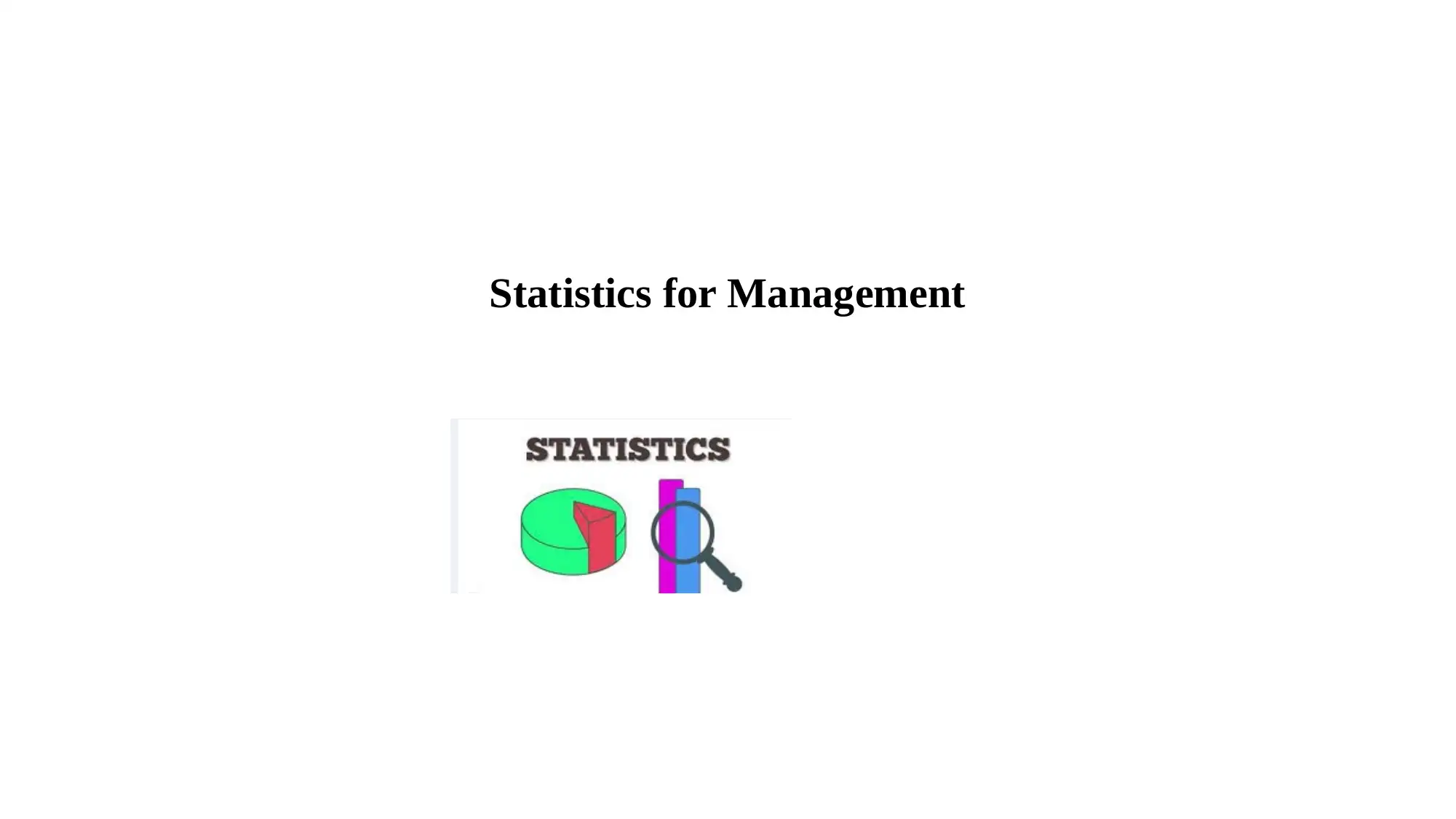
Statistics for Management
Paraphrase This Document
Need a fresh take? Get an instant paraphrase of this document with our AI Paraphraser
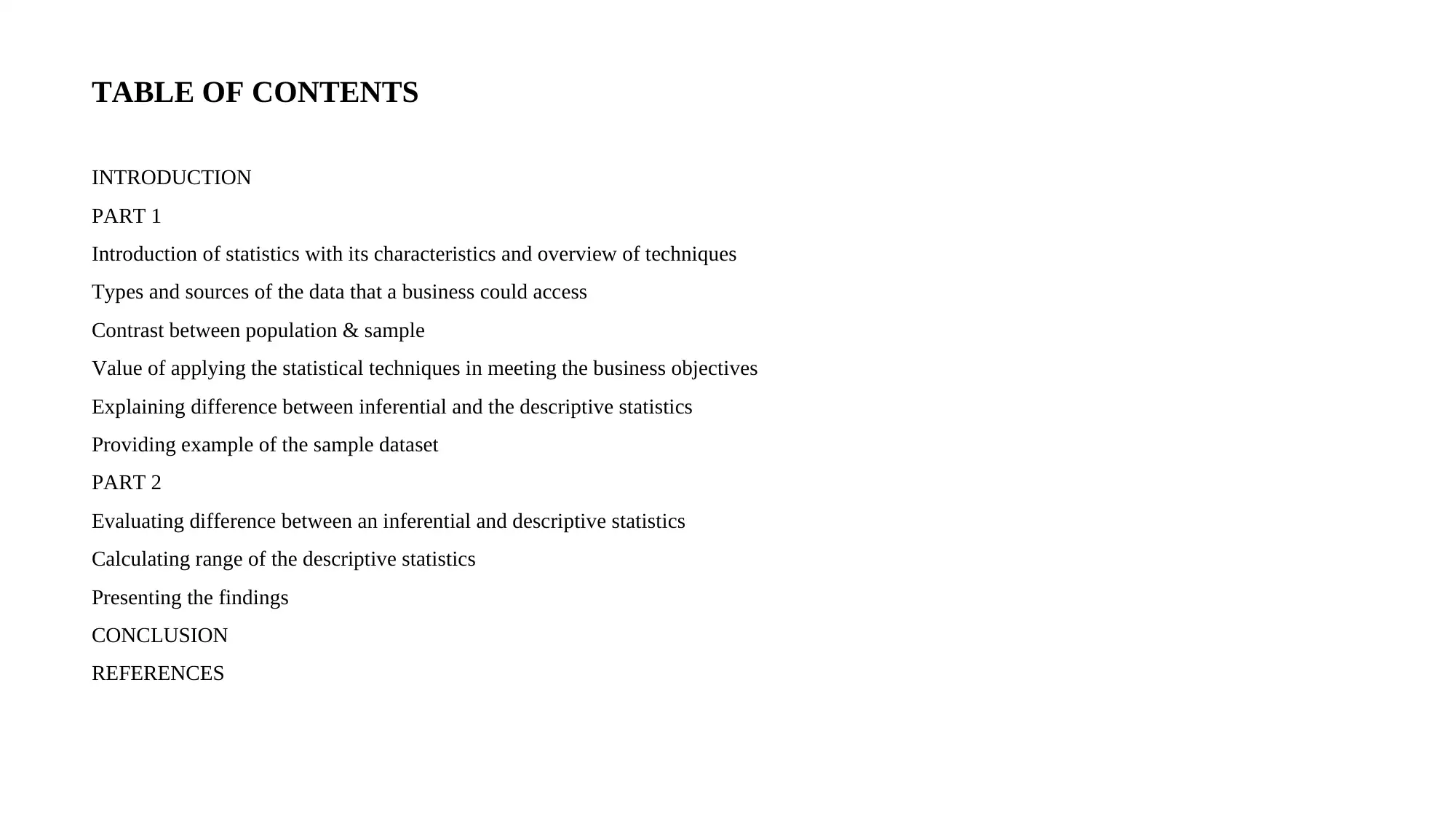
TABLE OF CONTENTS
INTRODUCTION
PART 1
Introduction of statistics with its characteristics and overview of techniques
Types and sources of the data that a business could access
Contrast between population & sample
Value of applying the statistical techniques in meeting the business objectives
Explaining difference between inferential and the descriptive statistics
Providing example of the sample dataset
PART 2
Evaluating difference between an inferential and descriptive statistics
Calculating range of the descriptive statistics
Presenting the findings
CONCLUSION
REFERENCES
INTRODUCTION
PART 1
Introduction of statistics with its characteristics and overview of techniques
Types and sources of the data that a business could access
Contrast between population & sample
Value of applying the statistical techniques in meeting the business objectives
Explaining difference between inferential and the descriptive statistics
Providing example of the sample dataset
PART 2
Evaluating difference between an inferential and descriptive statistics
Calculating range of the descriptive statistics
Presenting the findings
CONCLUSION
REFERENCES
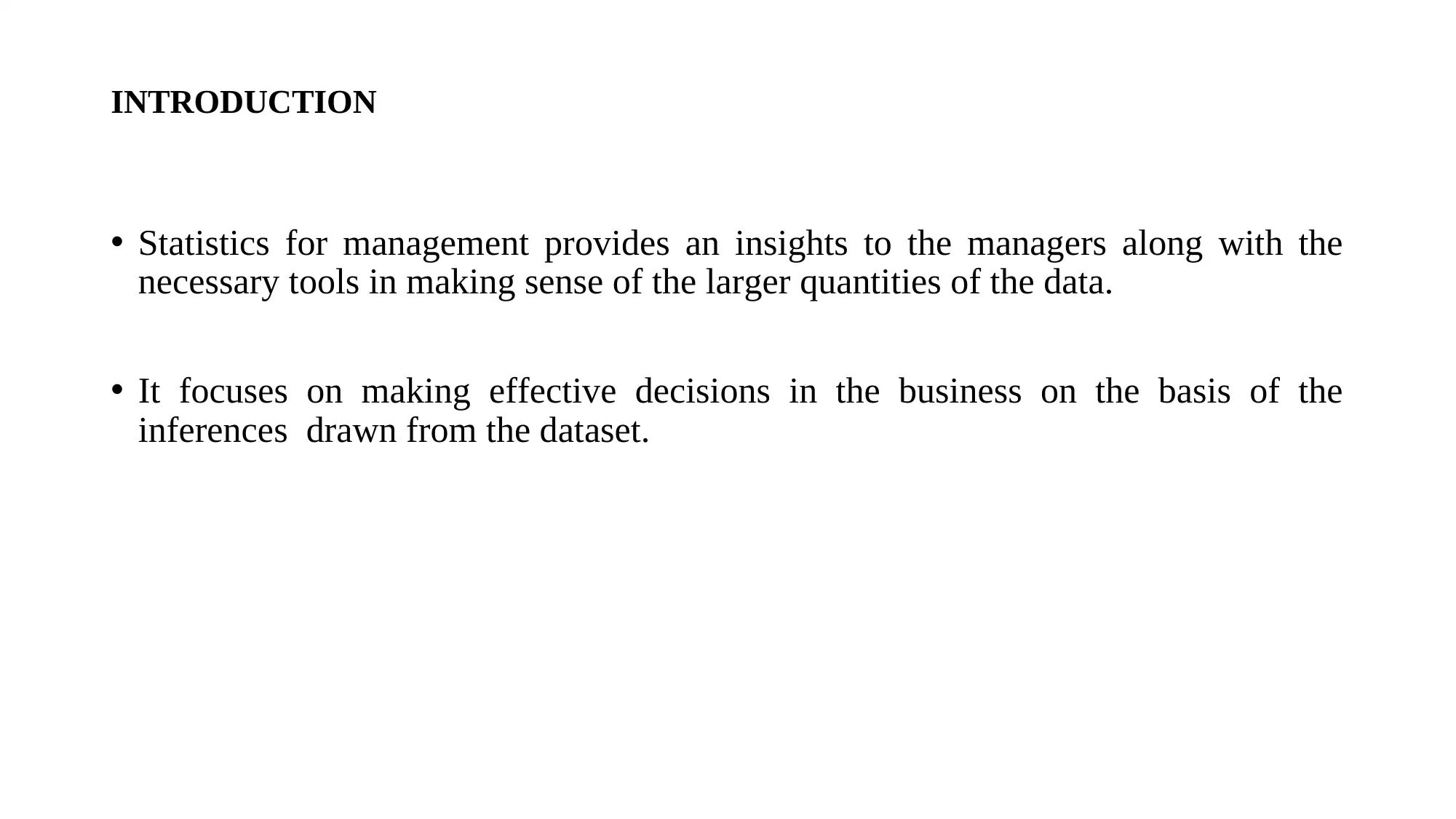
INTRODUCTION
• Statistics for management provides an insights to the managers along with the
necessary tools in making sense of the larger quantities of the data.
• It focuses on making effective decisions in the business on the basis of the
inferences drawn from the dataset.
• Statistics for management provides an insights to the managers along with the
necessary tools in making sense of the larger quantities of the data.
• It focuses on making effective decisions in the business on the basis of the
inferences drawn from the dataset.
⊘ This is a preview!⊘
Do you want full access?
Subscribe today to unlock all pages.

Trusted by 1+ million students worldwide
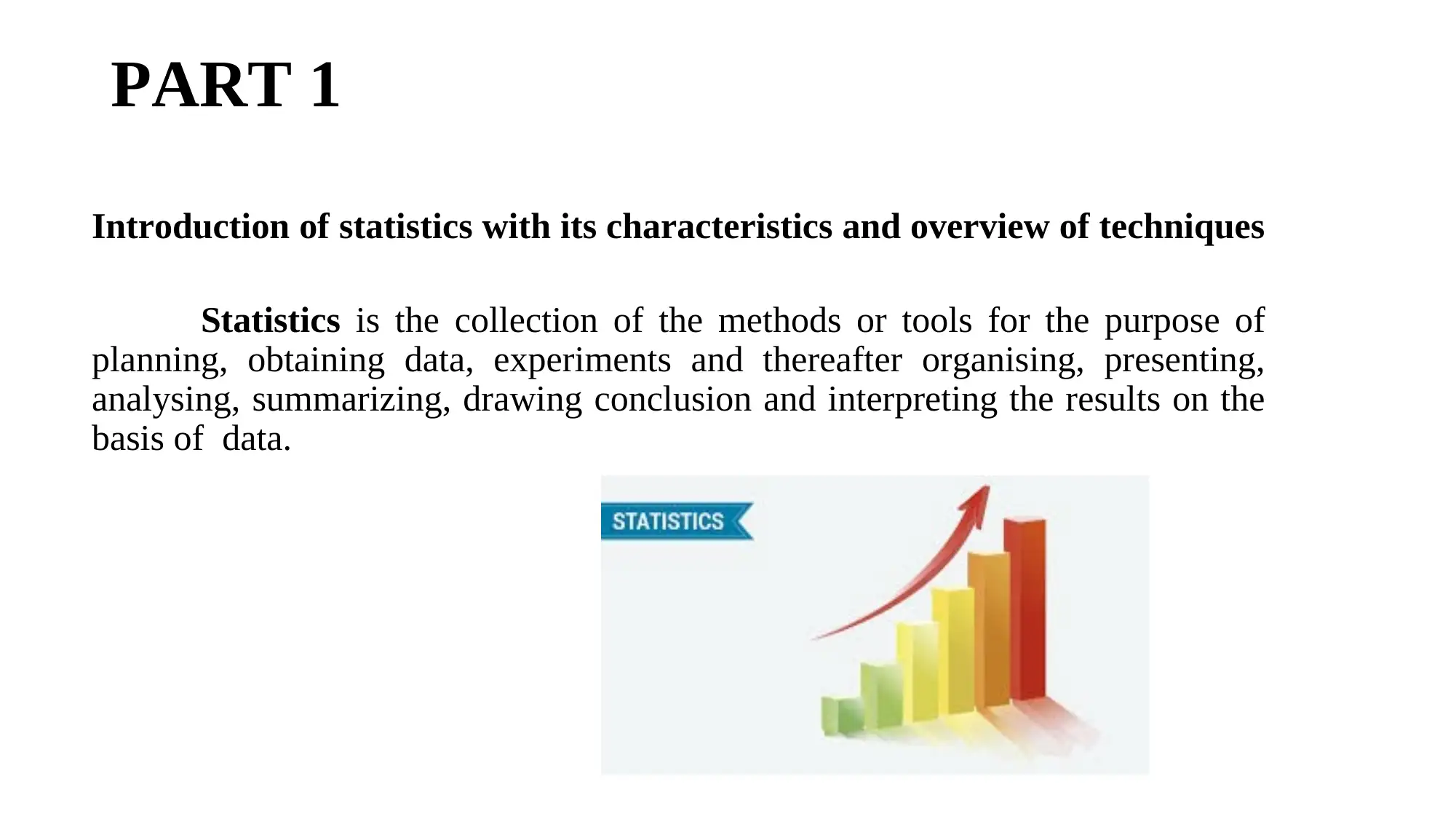
PART 1
Introduction of statistics with its characteristics and overview of techniques
Statistics is the collection of the methods or tools for the purpose of
planning, obtaining data, experiments and thereafter organising, presenting,
analysing, summarizing, drawing conclusion and interpreting the results on the
basis of data.
Introduction of statistics with its characteristics and overview of techniques
Statistics is the collection of the methods or tools for the purpose of
planning, obtaining data, experiments and thereafter organising, presenting,
analysing, summarizing, drawing conclusion and interpreting the results on the
basis of data.
Paraphrase This Document
Need a fresh take? Get an instant paraphrase of this document with our AI Paraphraser
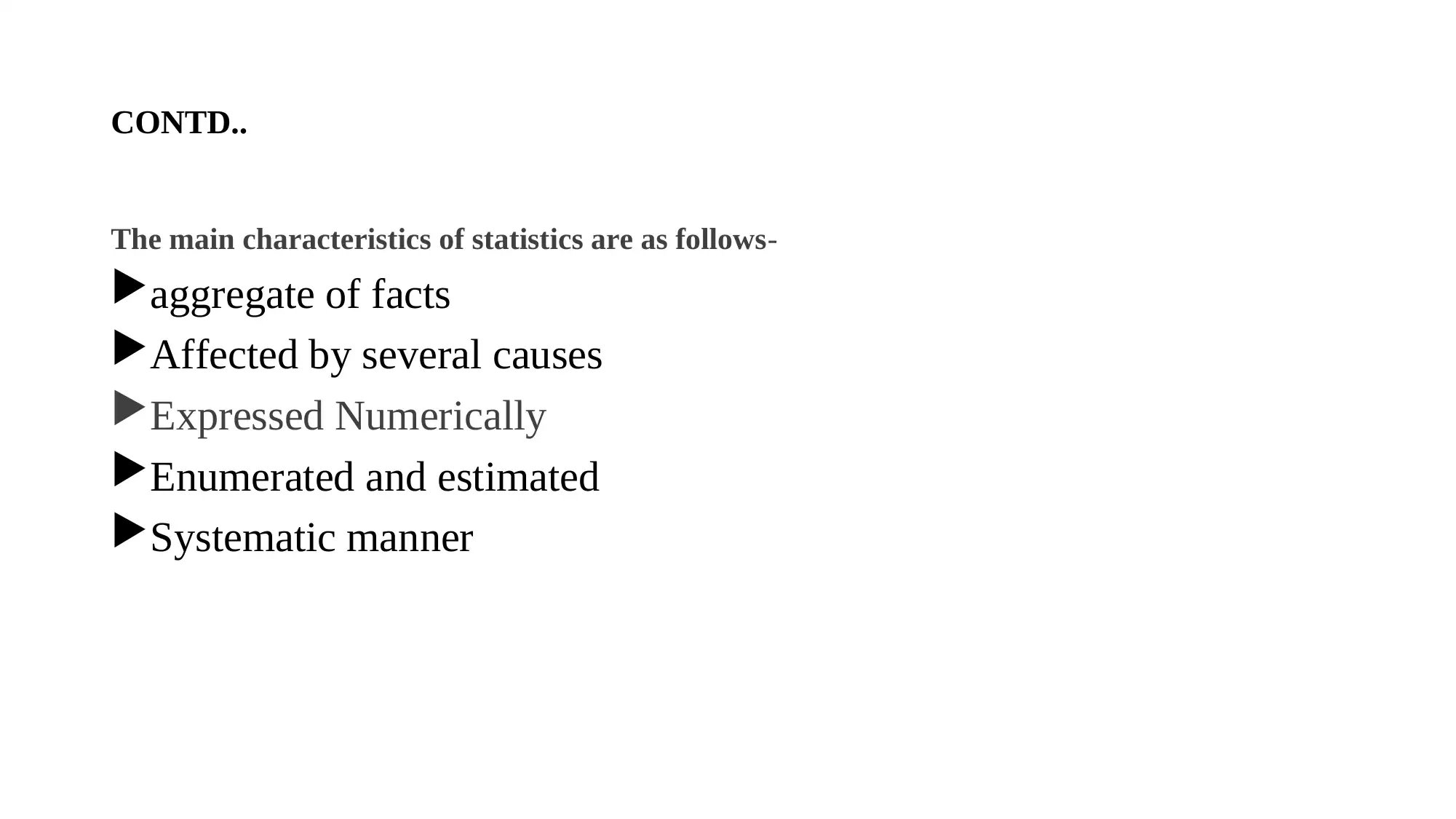
CONTD..
The main characteristics of statistics are as follows-
aggregate of facts
Affected by several causes
Expressed Numerically
Enumerated and estimated
Systematic manner
The main characteristics of statistics are as follows-
aggregate of facts
Affected by several causes
Expressed Numerically
Enumerated and estimated
Systematic manner
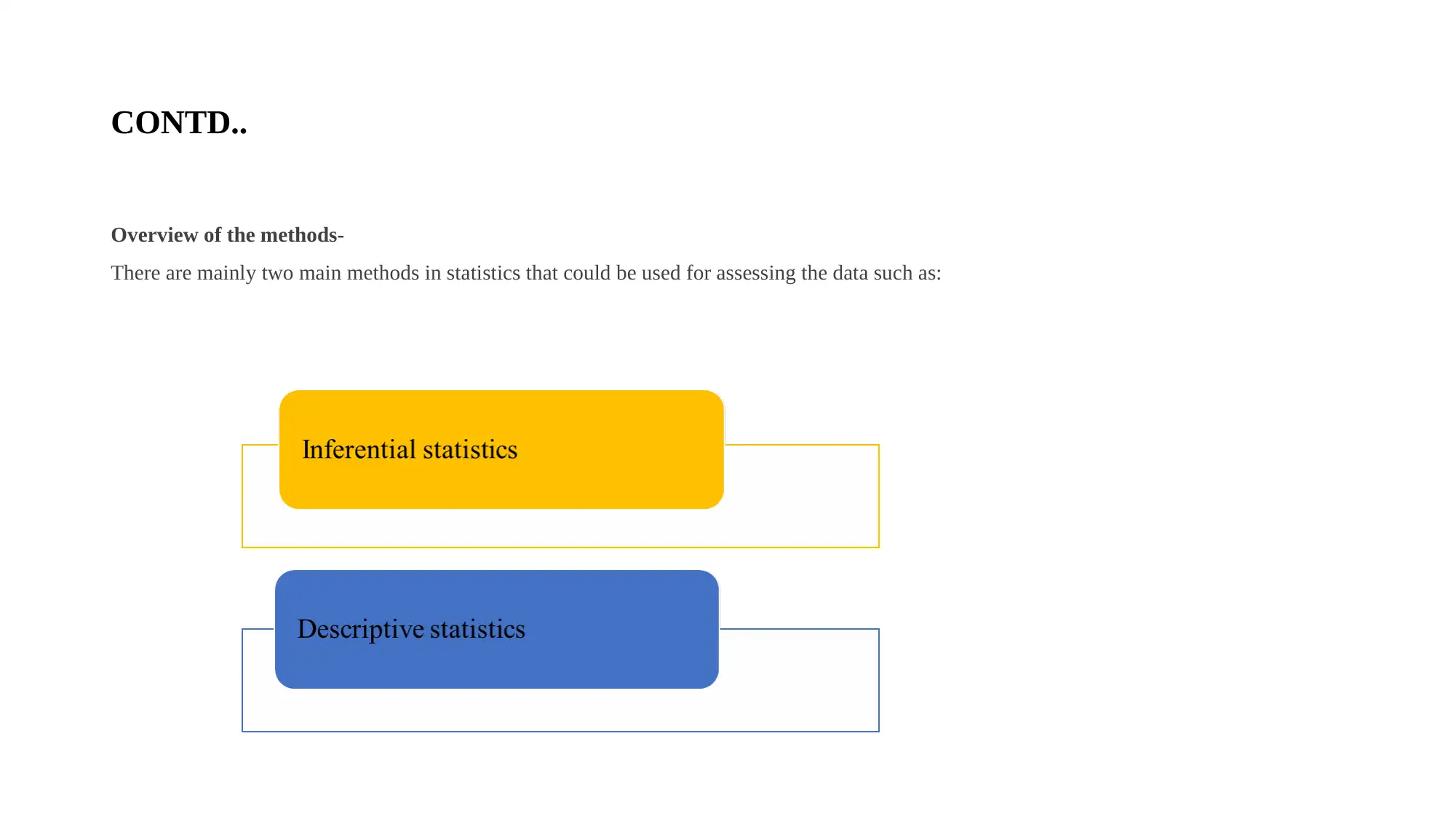
CONTD..
Overview of the methods-
There are mainly two main methods in statistics that could be used for assessing the data such as:
Overview of the methods-
There are mainly two main methods in statistics that could be used for assessing the data such as:
⊘ This is a preview!⊘
Do you want full access?
Subscribe today to unlock all pages.

Trusted by 1+ million students worldwide
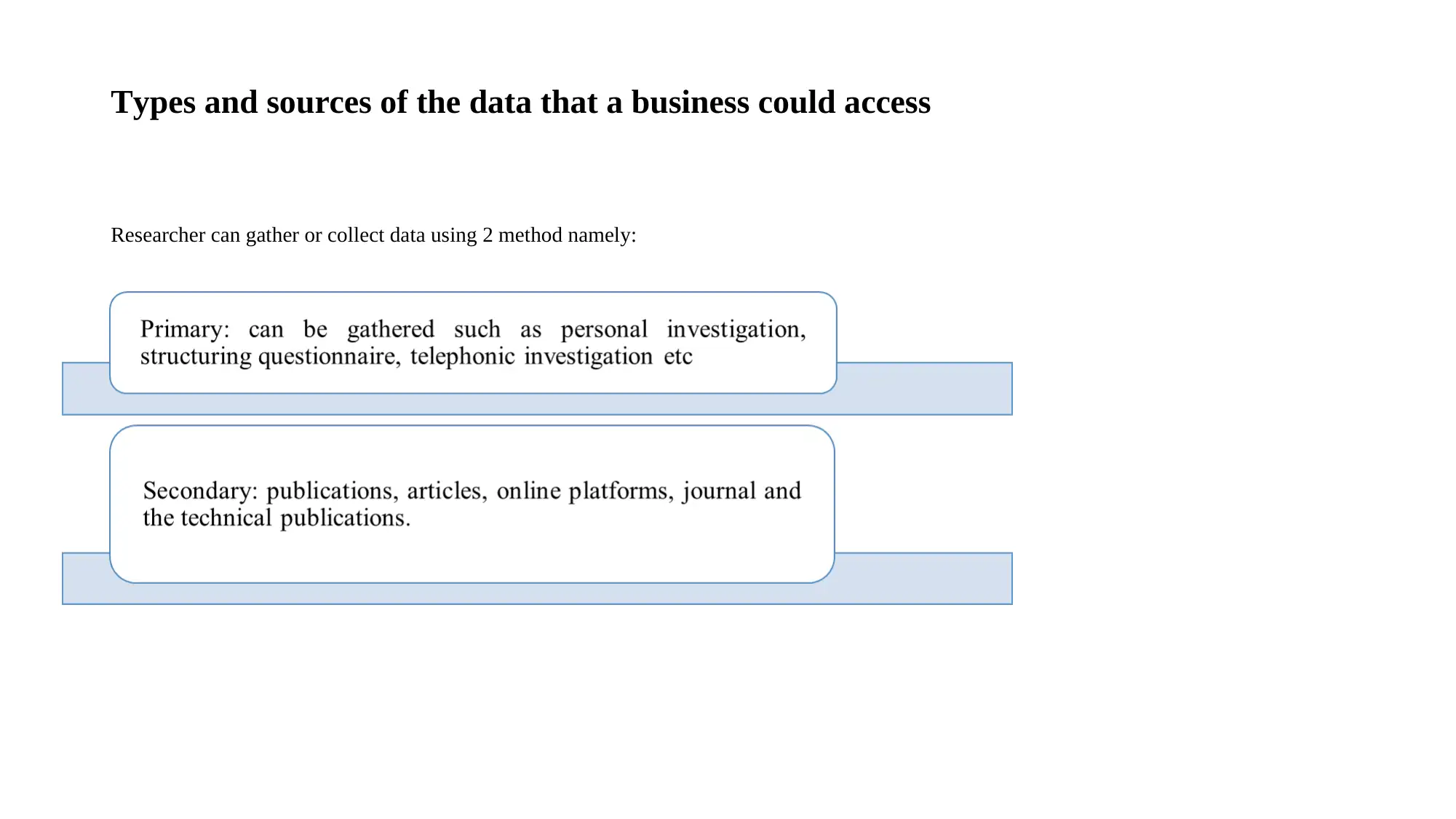
Types and sources of the data that a business could access
Researcher can gather or collect data using 2 method namely:
Researcher can gather or collect data using 2 method namely:
Paraphrase This Document
Need a fresh take? Get an instant paraphrase of this document with our AI Paraphraser
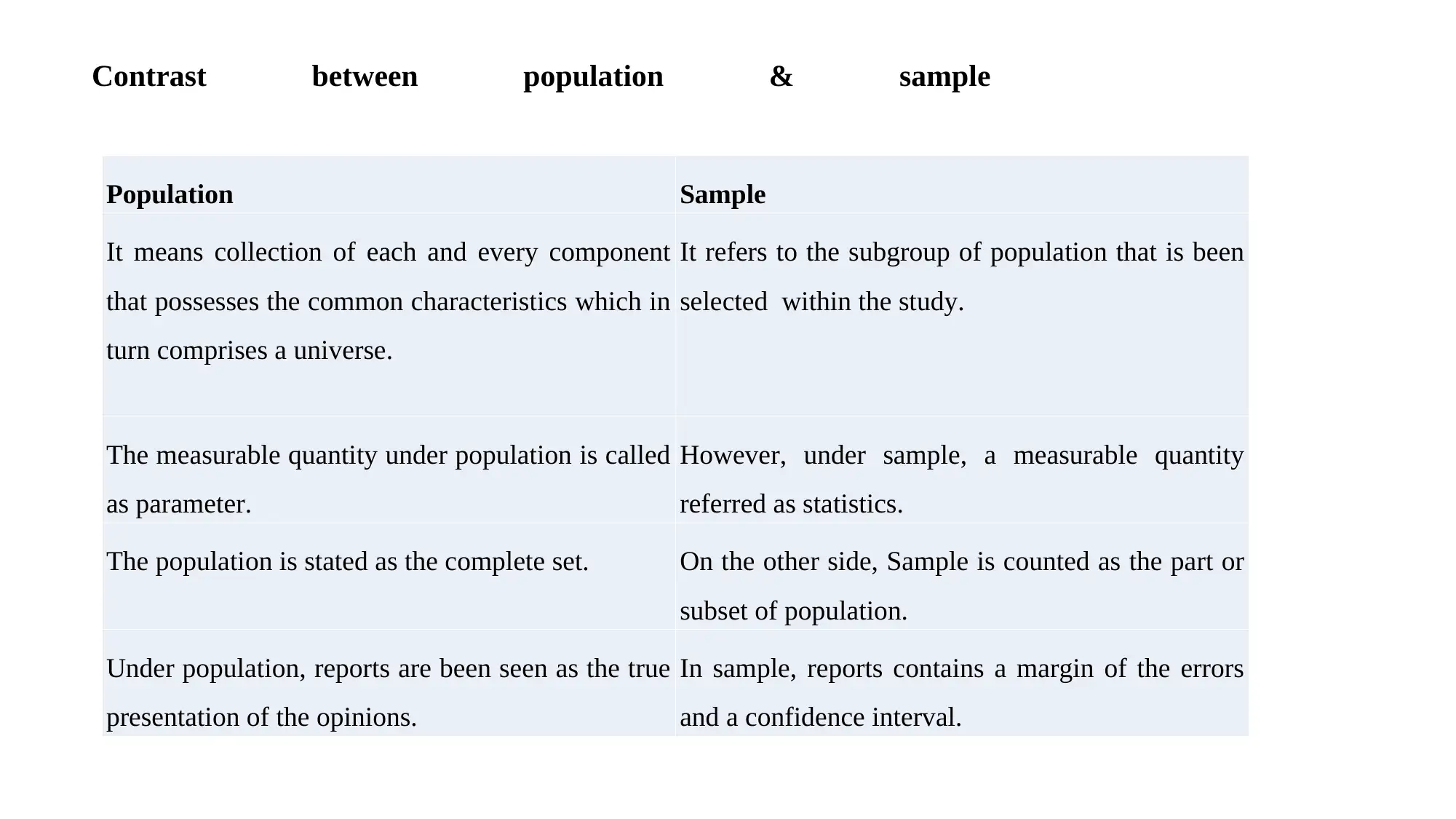
Contrast between population & sample
Population Sample
It means collection of each and every component
that possesses the common characteristics which in
turn comprises a universe.
It refers to the subgroup of population that is been
selected within the study.
The measurable quantity under population is called
as parameter.
However, under sample, a measurable quantity
referred as statistics.
The population is stated as the complete set. On the other side, Sample is counted as the part or
subset of population.
Under population, reports are been seen as the true
presentation of the opinions.
In sample, reports contains a margin of the errors
and a confidence interval.
Population Sample
It means collection of each and every component
that possesses the common characteristics which in
turn comprises a universe.
It refers to the subgroup of population that is been
selected within the study.
The measurable quantity under population is called
as parameter.
However, under sample, a measurable quantity
referred as statistics.
The population is stated as the complete set. On the other side, Sample is counted as the part or
subset of population.
Under population, reports are been seen as the true
presentation of the opinions.
In sample, reports contains a margin of the errors
and a confidence interval.
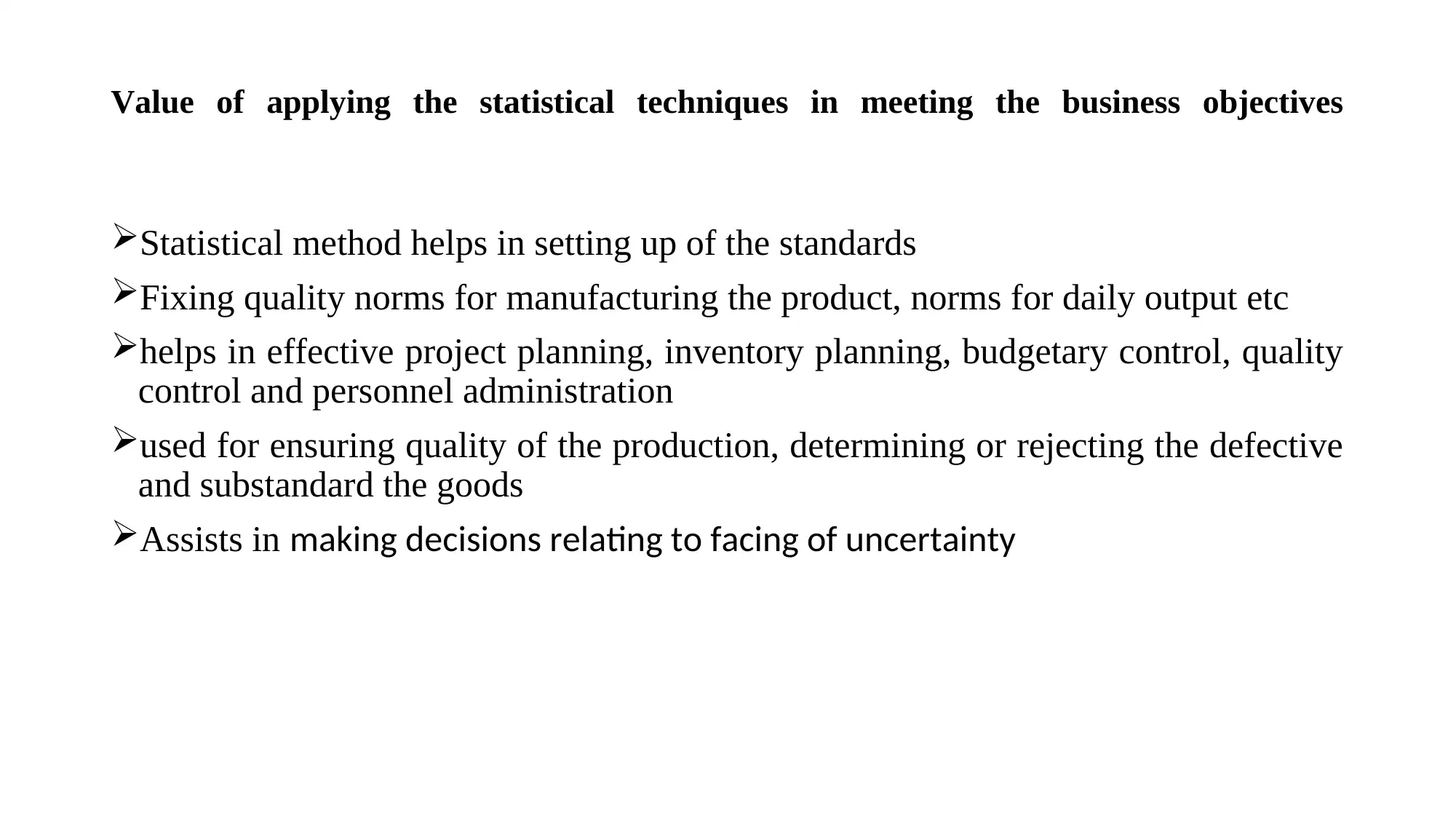
Value of applying the statistical techniques in meeting the business objectives
Statistical method helps in setting up of the standards
Fixing quality norms for manufacturing the product, norms for daily output etc
helps in effective project planning, inventory planning, budgetary control, quality
control and personnel administration
used for ensuring quality of the production, determining or rejecting the defective
and substandard the goods
Assists in making decisions relating to facing of uncertainty
Statistical method helps in setting up of the standards
Fixing quality norms for manufacturing the product, norms for daily output etc
helps in effective project planning, inventory planning, budgetary control, quality
control and personnel administration
used for ensuring quality of the production, determining or rejecting the defective
and substandard the goods
Assists in making decisions relating to facing of uncertainty
⊘ This is a preview!⊘
Do you want full access?
Subscribe today to unlock all pages.

Trusted by 1+ million students worldwide
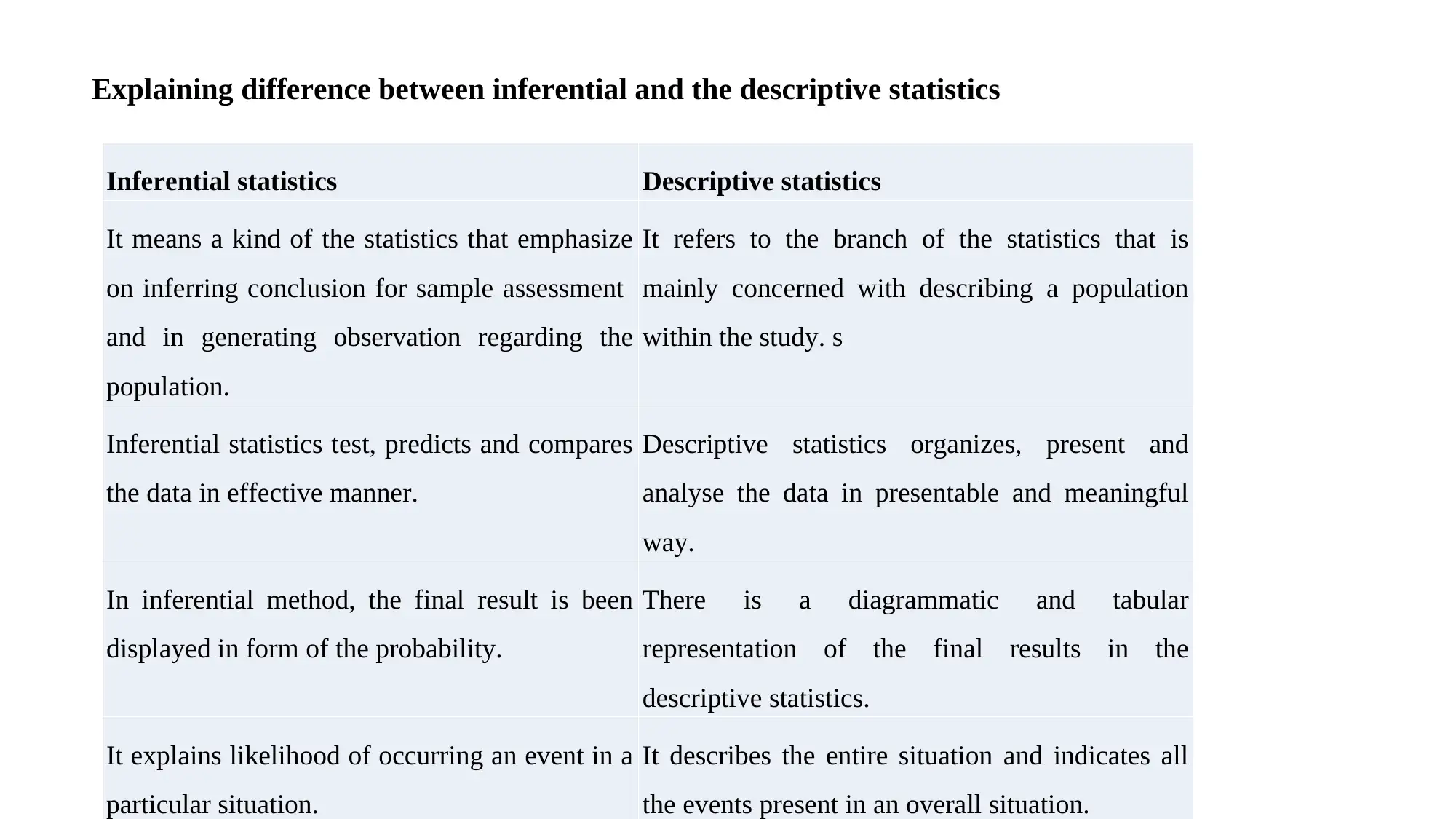
Explaining difference between inferential and the descriptive statistics
Inferential statistics Descriptive statistics
It means a kind of the statistics that emphasize
on inferring conclusion for sample assessment
and in generating observation regarding the
population.
It refers to the branch of the statistics that is
mainly concerned with describing a population
within the study. s
Inferential statistics test, predicts and compares
the data in effective manner.
Descriptive statistics organizes, present and
analyse the data in presentable and meaningful
way.
In inferential method, the final result is been
displayed in form of the probability.
There is a diagrammatic and tabular
representation of the final results in the
descriptive statistics.
It explains likelihood of occurring an event in a
particular situation.
It describes the entire situation and indicates all
the events present in an overall situation.
Inferential statistics Descriptive statistics
It means a kind of the statistics that emphasize
on inferring conclusion for sample assessment
and in generating observation regarding the
population.
It refers to the branch of the statistics that is
mainly concerned with describing a population
within the study. s
Inferential statistics test, predicts and compares
the data in effective manner.
Descriptive statistics organizes, present and
analyse the data in presentable and meaningful
way.
In inferential method, the final result is been
displayed in form of the probability.
There is a diagrammatic and tabular
representation of the final results in the
descriptive statistics.
It explains likelihood of occurring an event in a
particular situation.
It describes the entire situation and indicates all
the events present in an overall situation.
Paraphrase This Document
Need a fresh take? Get an instant paraphrase of this document with our AI Paraphraser
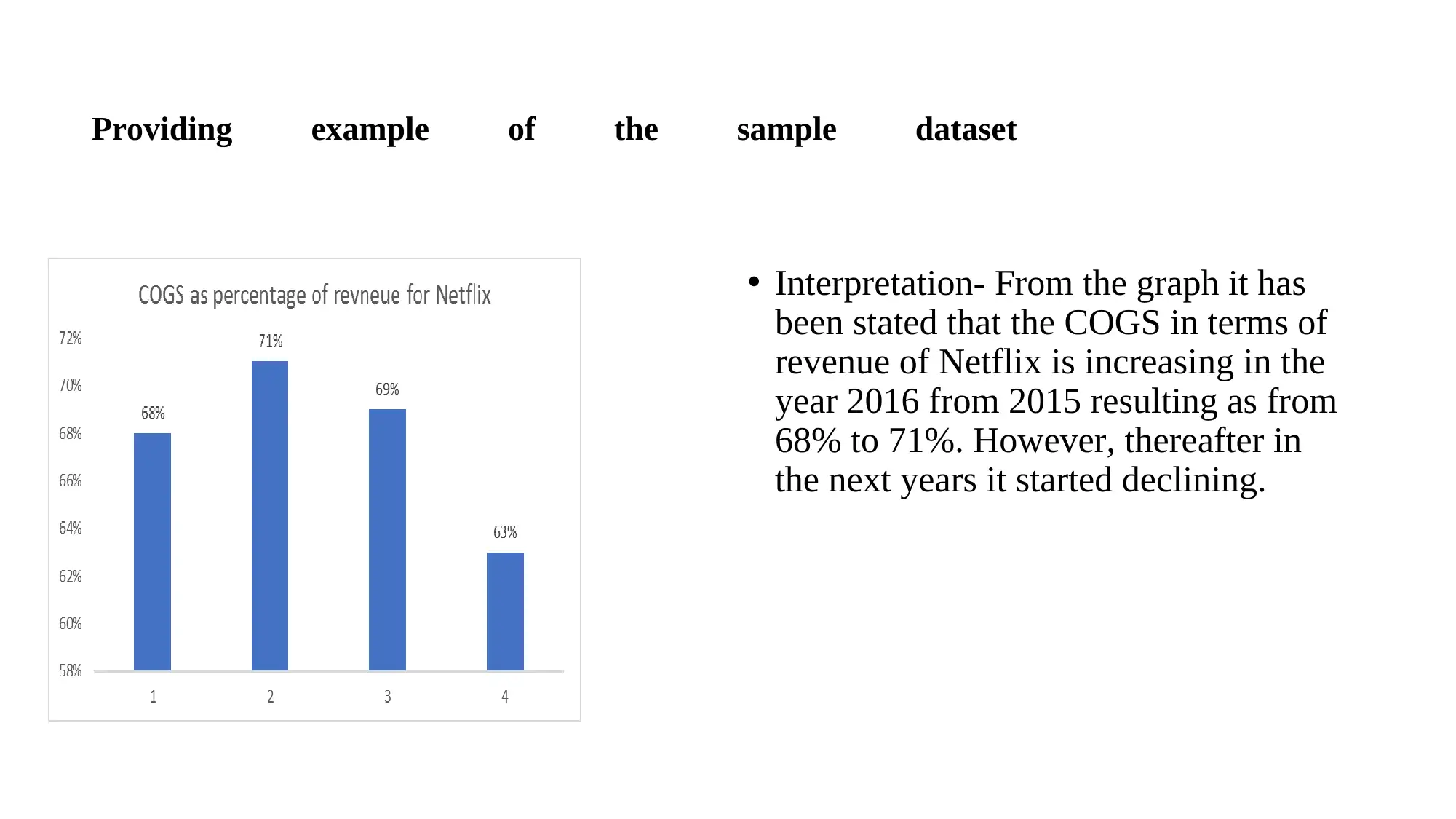
Providing example of the sample dataset
• Interpretation- From the graph it has
been stated that the COGS in terms of
revenue of Netflix is increasing in the
year 2016 from 2015 resulting as from
68% to 71%. However, thereafter in
the next years it started declining.
• Interpretation- From the graph it has
been stated that the COGS in terms of
revenue of Netflix is increasing in the
year 2016 from 2015 resulting as from
68% to 71%. However, thereafter in
the next years it started declining.
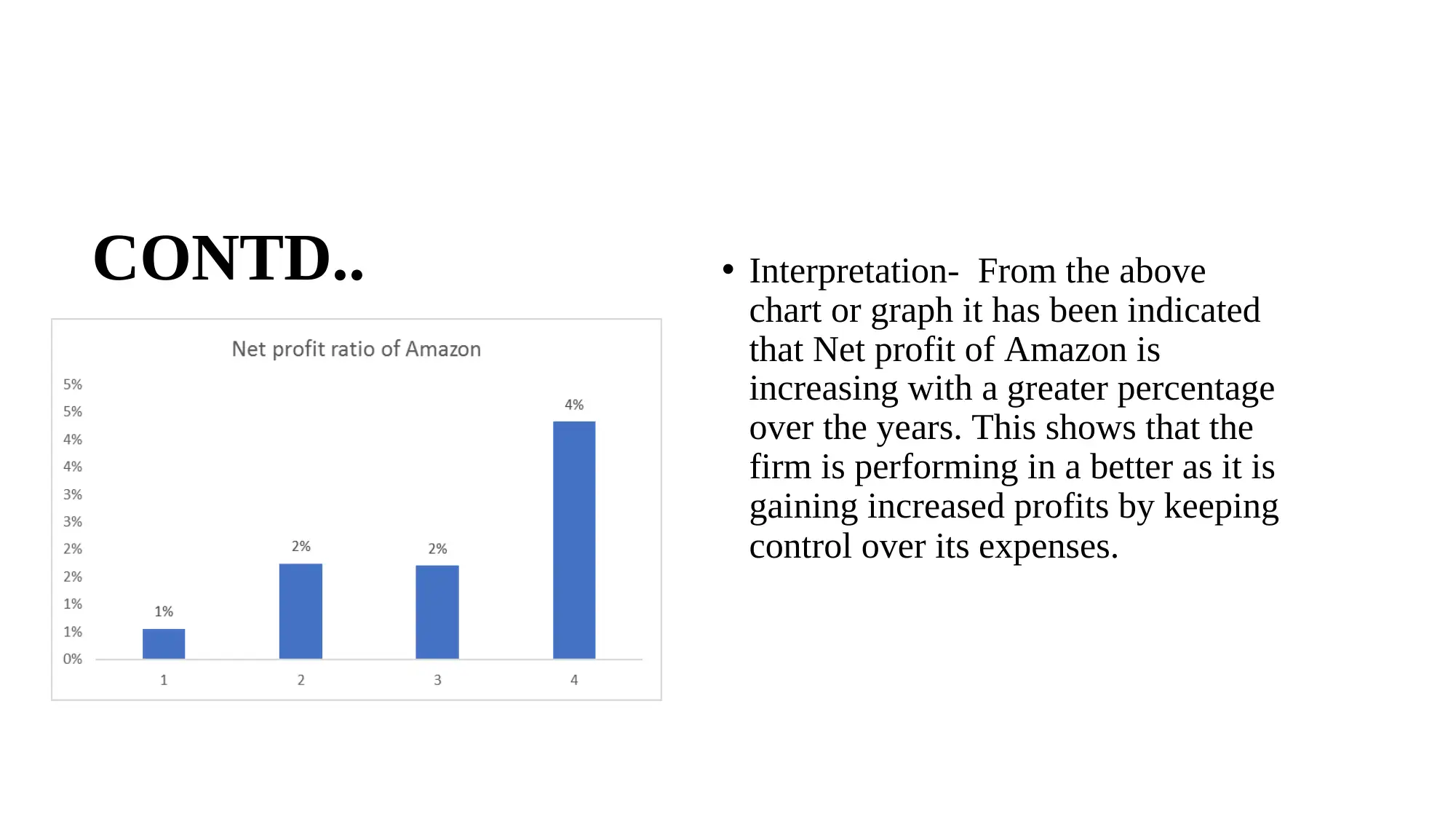
CONTD.. • Interpretation- From the above
chart or graph it has been indicated
that Net profit of Amazon is
increasing with a greater percentage
over the years. This shows that the
firm is performing in a better as it is
gaining increased profits by keeping
control over its expenses.
chart or graph it has been indicated
that Net profit of Amazon is
increasing with a greater percentage
over the years. This shows that the
firm is performing in a better as it is
gaining increased profits by keeping
control over its expenses.
⊘ This is a preview!⊘
Do you want full access?
Subscribe today to unlock all pages.

Trusted by 1+ million students worldwide
1 out of 16
Related Documents
Your All-in-One AI-Powered Toolkit for Academic Success.
+13062052269
info@desklib.com
Available 24*7 on WhatsApp / Email
![[object Object]](/_next/static/media/star-bottom.7253800d.svg)
Unlock your academic potential
Copyright © 2020–2025 A2Z Services. All Rights Reserved. Developed and managed by ZUCOL.





